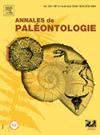A rare occurrence of Lamellaptychus (ammonoid jaw) from the Tethyan Himalaya and updated Indian aptychus record
IF 0.7
4区 地球科学
Q4 PALEONTOLOGY
引用次数: 0
Abstract
The jaw apparatuses of ammonoids are rarely discovered in the fossil record. Here, we describe the first and sole record of the aptychus type lower jaw of ammonoid Lamellaptychus lamellosus (Parkinson, 1811) from the Tethyan Himalaya. The aptychus was collected from the Demul section, representing the succession of Upper member of the Spiti Shale Formation. It is discovered from a micaceous silty clay horizon with bivalves (Inoceramus), serpulids, gastropods, ?brachiopods, crinoid ossicles, belemnites and ammonites. The age-diagnostic ammonites, ?Streblites (Oppeliidae) and cf. Aulacosphinctes sp. (Himalayitidae), suggest a Late Tithonian (Ponti–Microcanthum zones) age for the aptychus. The para-species L. lamellosus is recorded for the first time and attributed to oppeliid, though in-situ material is required for a conclusive result. Given the latest advances in the aptychus study, the previous Indian records are re-evaluated. The results suggest that L. kachhensis (Trauth, 1938) from Kachchh Basin is a para-subspecies of L. sparsilamellosus (Gümbel, 1861) rather than a valid para-species of Lamellaptychus genus. In addition, a closer observation of placenticeratid ammonite jaws from the Cretaceous of Narmada Basin shows that bivalves were misidentified as aptychi.
特提斯-喜马拉雅地区罕见的板爪龙(氨样颚)与更新的印度板爪龙记录
菊石的颚器在化石记录中很少被发现。本文描述了在特提斯喜马拉雅地区发现的第一个也是唯一的单爪龙Lamellaptychus lamellosus (Parkinson, 1811)的颚型下颌。在Demul剖面中采集的爪龙代表了斯皮提页岩组上段的演替。它是在云母质粉质粘土层中发现的,有双壳类动物、蛇形动物、腹足类动物、腕足类动物、海百合类小骨动物、蓝柱石和菊石。由Streblites (Oppeliidae)和cf. Aulacosphinctes sp.(喜马拉雅科)这两种菊石的年龄判断,表明该爪龙的年龄为晚梯东世(Ponti-Microcanthum带)。这是首次记录到的副种,并将其归为oppeliid,但需要现场资料才能得出结论。鉴于对aptychus研究的最新进展,之前的印度记录被重新评估。结果表明,Kachchh盆地的L. kachhensis (Trauth, 1938)是L. sparsilamellosus (g mbel, 1861)的准亚种,而不是Lamellaptychus属的准种。此外,对纳尔马达盆地白垩纪placenticeratid菊石颌骨的进一步观察表明,双壳类被误认为aptychi。
本文章由计算机程序翻译,如有差异,请以英文原文为准。
求助全文
约1分钟内获得全文
求助全文
来源期刊

Annales de Paleontologie
地学-古生物学
CiteScore
1.70
自引率
10.00%
发文量
8
审稿时长
>12 weeks
期刊介绍:
Créées par Marcellin Boule en 1905, les Annales de Paléontologie publient 4 numéros par an traitant des fossiles animaux et végétaux, dans tous les domaines de la paléontologie incluant :
-La Paléoanatomie-
La Paléohistologie-
La Morphologie fonctionnelle-
La Systématique-
L''Évolution-
La Paléoécologie
... et toute les contributions susceptibles d''améliorer la compréhension des organismes et des environnements éteints.
 求助内容:
求助内容: 应助结果提醒方式:
应助结果提醒方式:


